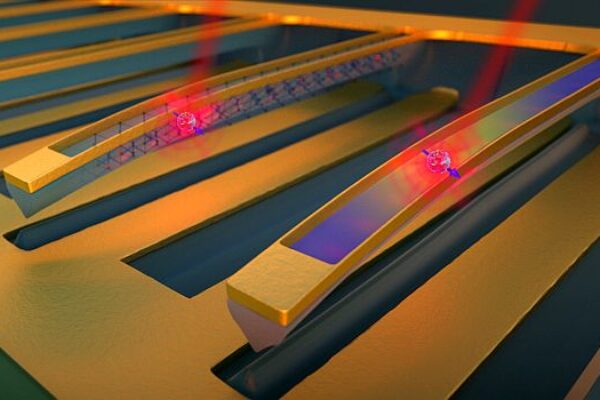
Tunable diamond strings promise quantum memory solution
Using quantum bits – or qubits – to carry information requires a quantum memory, an atomic-scale device that can store quantum information and convert it into light to transmit across the network. A major challenge to this is the extremely sensitive nature of qubits – even vibrations of nearby atoms can disrupt their ability to remember information.
Up to now, extremely low temperatures have been used to quiet vibrations, but achieving those temperatures for large-scale quantum networks is prohibitively expensive. However, this new research takes a different approach by using engineered diamond strings that can be tuned to quiet a qubit’s environment and improve memory from tens to several hundred nanoseconds – enough time to do many operations on a quantum chip.
“Impurities in diamond have emerged as promising nodes for quantum networks,” says Marko Loncar, the Tiantsai Lin Professor of Electrical Engineering at SEAS and senior author of the research. “However, they are not perfect. Some kinds of impurities are really good at retaining information but have a hard time communicating, while others are really good communicators but suffer from memory loss. In this work, we took the latter kind, and improved the memory by ten times.”
Impurities in diamond – known as silicon-vacancy color centers – are powerful qubits, say the researchers. An electron trapped in the center acts as a memory bit and can emit single photons of red light, which would in turn act as long-distance information carriers of a quantum internet. But with the nearby atoms in the diamond crystal vibrating randomly, the electron in the center quickly forgets any quantum information it is asked to remember.
“Being an electron in a color center is like trying to study at a loud marketplace,” says Srujan Meesala, a graduate student at SEAS and co-first author of the paper on the research. “There is all this noise around you. If you want to remember anything, you need to either ask the crowds to stay quiet or find a way to focus over the noise. We did the latter.”
To do this, the researchers carved the diamond crystal housing the color center into a thin string, about one micron wide – a hundred times thinner than a strand of hair – and attached electrodes to each side. By applying a voltage, the diamond string stretches and increases the frequency of vibrations the electron is sensitive to – just like tightening a guitar string increases the frequency or pitch of the string.
“By creating tension in the string, we increase the energy scale of vibrations that the electron is sensitive to, meaning it can now only feel very high energy vibrations,” says Meesala. “This process effectively turns the surrounding vibrations in the crystal to an irrelevant background hum, allowing the electron inside the vacancy to comfortably hold information for hundreds of nanoseconds, which can be a really long time on the quantum scale. A symphony of these tunable diamond strings could serve as the backbone of a future quantum internet.”
The researchers next hope to extend the memory of the qubits to the millisecond, which would enable hundreds of thousands of operations and long-distance quantum communication. For more, see “Controlling the coherence of a diamond spin qubit through its strain environment.”
Related articles:
Quantum internet moves closer to reality
Rambus, Microsoft expand cryogenic memory effort
Practical photon source for quantum communication
2018 to mark ‘new era’ for quantum computing, says report
 If you enjoyed this article, you will like the following ones: don't miss them by subscribing to :
eeNews on Google News
If you enjoyed this article, you will like the following ones: don't miss them by subscribing to :
eeNews on Google News




